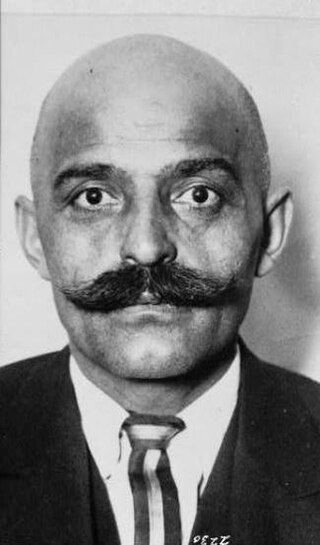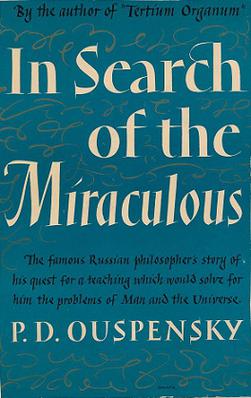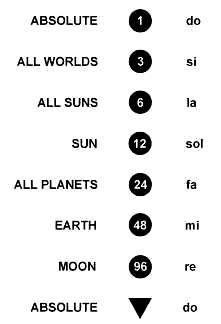
George Ivanovich Gurdjieff was a philosopher, mystic, spiritual teacher, composer, and “dance teacher”. Gurdjieff taught that people are not conscious of themselves and thus live their lives in a state of hypnotic "waking sleep", but that it is possible to awaken to a higher state of consciousness and serve our purpose as human beings. The practice of his teaching has become known as "The Work" and is additional to the ways of the fakir, monk and yogi, so that his student P. D. Ouspensky referred to it as the "Fourth Way".
Pyotr Demianovich Ouspenskii was a Russian philosopher and esotericist known for his expositions of the early work of the Greek-Armenian teacher of esoteric doctrine George Gurdjieff. He met Gurdjieff in Moscow in 1915, and was associated with the ideas and practices originating with Gurdjieff from then on. He taught ideas and methods based in the Gurdjieff system for 25 years in England and the United States, although he separated from Gurdjieff personally in 1924, for reasons that are explained in the last chapter of his book In Search of the Miraculous.
John Godolphin Bennett was a British academic and author.

In Search of the Miraculous: Fragments of an Unknown Teaching is a 1949 book by Russian philosopher P. D. Ouspensky which recounts his meeting and subsequent association with George Gurdjieff.
The Fourth Way is an approach to self-development developed by George Gurdjieff over years of travel in the East. It combines and harmonizes what he saw as three established traditional "ways" or "schools": first, those of the body; second, the emotions; and third, the mind. Students often refer to the Fourth Way as "The Work", "Work on oneself", or "The System". The exact origins of some of Gurdjieff's teachings are unknown, but various sources have been suggested.

Henry Maurice Dunlop Nicoll was a Scottish neurologist, psychiatrist, author and noted Fourth Way esoteric teacher. He is best known for his Psychological Commentaries on the Teaching of Gurdjieff and Ouspensky, a five-volume collection of more than 500 talks given and distributed to his study groups in and around London from March 1941 to August 1953.

A subtle body is a "quasi material" aspect of the human body, being neither solely physical nor solely spiritual, according to various esoteric, occult, and mystical teachings. This contrasts with the mind–body dualism that has dominated Western thought. The subtle body is important in the Taoism of China and Dharmic religions such as Hinduism, Buddhism, and Jainism, mainly in the branches which focus on tantra and yoga, where it is known as the Sūkṣma-śarīra. However, while mostly associated with Asian cultures, non-dualistic approaches to the mind and body are found in many parts of the world.
In Hindu philosophy, turiya, also referred to as chaturiya, chaturtha, is the true self (atman) beyond the three common states of consciousness. It is postulated in several Upanishads and explicated in Gaudapada's Mandukya Karika.
The term involution has various meanings. In some instances it refers to a process prior to evolution which gives rise to the cosmos, in others it is an aspect of evolution, and in still others it is a process that follows the completion of evolution in the human form.

The Fourth Way (1957) is a book about the Fourth Way, a system of self-development as introduced by Greek-Armenian philosopher G.I. Gurdjieff. It is a compilation of the lectures of P. D. Ouspensky at London and New York City between the years 1921 through 1946, published posthumously by his students in 1957.

The Ray of Creation is an esoteric cosmology which was taught by G. I. Gurdjieff. It is a diagram which better represents the place which Earth occupies in the Universe. The diagram has eight levels, each corresponding to Gurdjieff's Law of Octaves.

Rodney George Collin-Smith, known as Rodney Collin, was a British writer who was prolific in the area of spiritual development. His work was heavily influenced by his teacher P. D. Ouspensky and, through him, G. I. Gurdjieff and their system of spiritual development. His best known work, The Theory of Celestial Influence, is an ambitious attempt to unite astronomy, physics, chemistry, human physiology and world history with his own version of planetary influences.
In G.I. Gurdjieff's Fourth Way teaching, also known as The Work, centers or brains refer to separate apparatuses within a being that dictate its specific functions. According to this teaching, there are three main centers: intellectual, emotional, and moving. These centers in the human body are analogous to a three-storey factory, the intellectual center being the top storey, the emotional center being the middle one, and the moving center being the bottom storey. The moving center, or the bottom storey is further divided into three separate functions: sex, instinctive, and motor.
Alfred Julius Emmanuel Sorensen, also known as Sunyata, Shunya, or Sunyabhai, was a Danish mystic, horticulturist and writer who lived in Europe, India and the US.
Dennis Lewis is a non-fiction writer and teacher in the areas of breathing, qigong, meditation, and self-enquiry.
Leon MacLaren, born Leonardo da Vinci MacLaren, was a British philosopher and the founder of the School of Economic Science (SES). MacLaren was inspired by Henry George, Socrates, Dr Francis Roles, Pyotr Ouspensky, Maharishi Mahesh Yogi, and finally the philosophy of Advaita Vedānta through the Shankaracharyas of Jyoti Math.
Ethel Merston was one of G. I. Gurdjieff’s first students at his Institute for the Harmonious Development of Man, at the Prieuré in Fontainebleau-en-Avon, France. Gurdjieff had recently come to the West to introduce an esoteric teaching called the Fourth Way. She wrote a memoir based on her diaries giving a keen insight into many of the seminal teachers of her times.

The Study Society is registered with the Charity Commission as Registered Charity Number 1155498. Its stated objects are for the public benefit:
- to advance the education of the public in religion, science, philosophy and the arts.
- the promotion of moral and spiritual welfare.

Robin Amis (1932–2014) was a British author, poet, publisher, editor and translator. Although he had studied a wide range of spiritual traditions, including Kabbalah, the Fourth Way and Hindu teachings, it was his conversion to the Eastern Orthodox Church and his relationship with Mount Athos, the ancient monastic republic in Greece, that ultimately defined his life and work. Over a thirty-year period, between 1982 and 2013, he made more than 60 visits to Mount Athos, where he was recognised as a "synergatis", a fellow worker and equal of the monks. Amis documented the results of his research in A Different Christianity: Early Christian Esotericism and Modern Thought, and recounted his experience on the Holy Mountain in Views from Mount Athos. As founder of Praxis Institute Press, he translated, edited and published the three-volume English language edition of Gnosis by Boris Mouravieff as well as books on Hesychasm and the spiritual tradition of Eastern Orthodoxy. He was married to the American artist Lillian Delevoryas and in the last years of his life lived in Bristol, England.
Boris Petrovich Mouravieff was a Russian historian, philosopher, writer and university professor. He is known for his three-volume work Gnosis: Study and Commentaries on the Esoteric Tradition of Eastern Orthodoxy.








